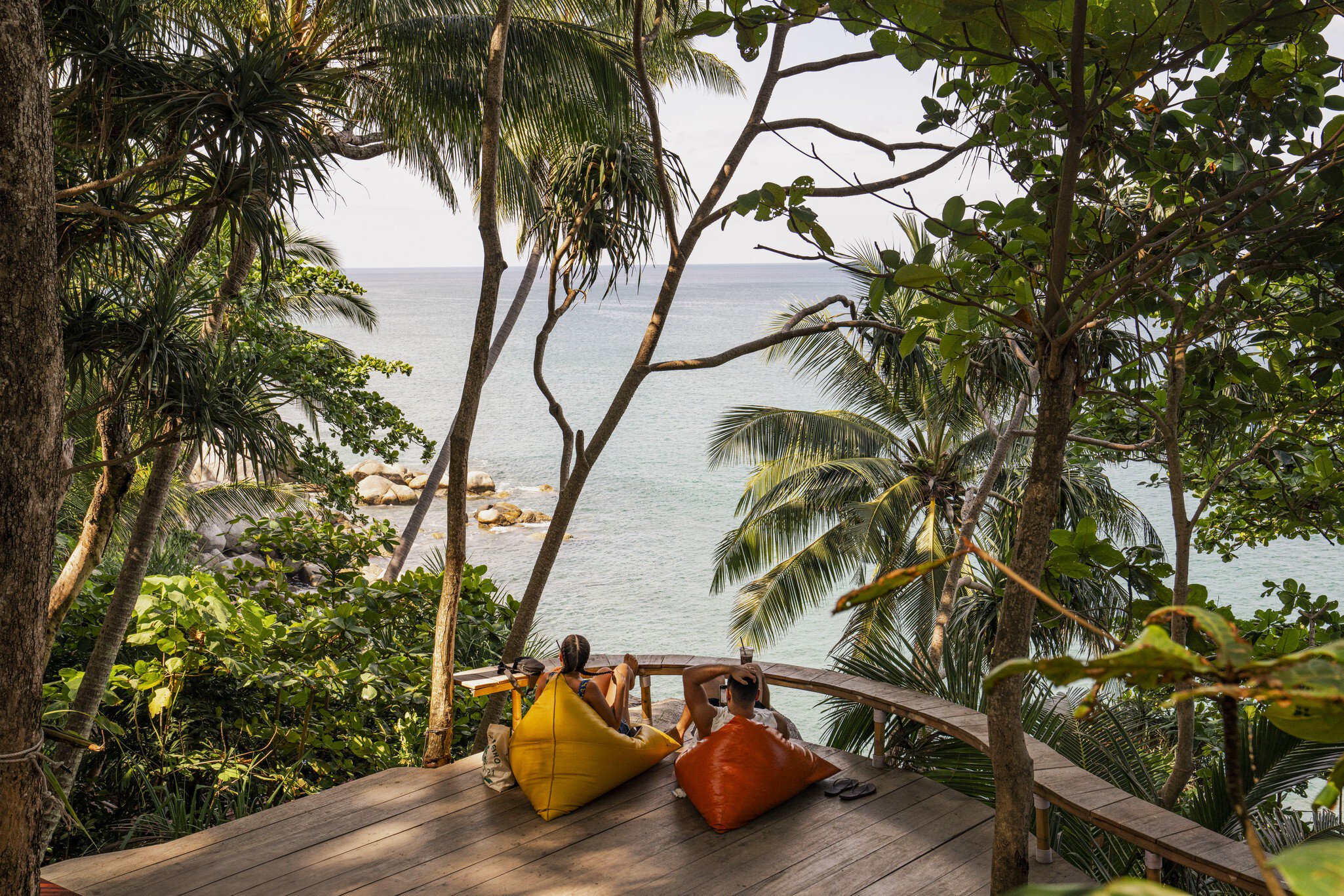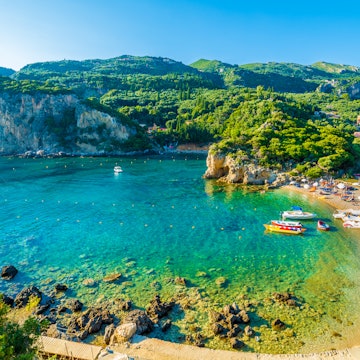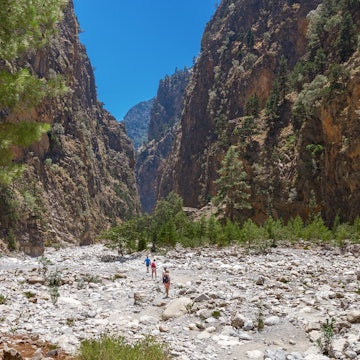

Oia village, Santorini. nexusby/Shutterstock
Even in today’s well-traveled world, there is still a genuine thrill to picking up a map of the Greek Islands, finding one you’ve never heard of and hopping on a ferry there pronto. These islands of Homeric myth and spellbinding beauty have never lost their ability to fire imaginations and conjure adventure. Step off the plane or boat and the stress slips instantly away in the heat-haze, as life calms and your only decision is which taverna to choose for a two-hour lunch and whether or not you prefer your beach with sand or pebbles.
Despite the call to unplug and do nothing, each of these distinctly individual islands is ripe for exploration: Venetian forts, volcano climbs, icon-crammed monasteries high on mountaintops, and vineyards producing wines as they’ve been made since antiquity will all tempt you away from the lounger. From the lush olive-cloaked Ionian Islands to the stylish, whitewashed Cyclades, read on for our absolute favorites.

1. Ikaria
Best for lessons in longevity
It takes effort to get to Ikaria, a wondrously wild island in the eastern Aegean, but those who make it this far are rewarded. Ruggedly mountainous, gorge-riven, thickly forested and well beyond the usual tourist radar, this island has its own look and culture. It swirls in legend, too – Homeric myth says that wine-loving god Dionysus was born here and you can visit the remote rock where Icarus flew too close to the sun, melted his wings, fell, bumped his head and drowned.
Infrastructure on Ikaria is patchy, so you’ll need your own wheels to get about, but that makes the island feel like a proper adventure. Strike out along the narrow roads and you’ll be captivated by the likes of frost-white, boulder-speckled Seychelles Beach and its dazzling azure waters, family-run Afianes Winery, high in the vine-strewn hills, and the sulfur-rich hot springs of Therma.
For centuries, islanders hid out in giant rock houses to avoid pirate attacks, and these can be visited by traipsing into the granite peaks on boulder-strewn monopatia (old footpaths). These stiff climbs – along with a herb-rich diet – are part of what contribute to the island’s extraordinarily high number of centenarians, making Ikaria one of the world’s five Blue Zones.
Planning tip: This isn’t an island to rush so allow two weeks minimum to let it truly work its magic. Twice weekly Dodekanisos Seaways ferries run between Kos and Agios Kirikos. The journey takes 3¼ hours, stopping off at other islands en route.

2. Alonissos
Best for marine life and mellow days
One island over from Skopelos of Mamma Mia! movie fame is an island in the Northern Sporades moving to a far more relaxed beat: Alonissos. There are no crowded boats belting out ABBA tunes here, just the backbeat of cicadas and the gentle shush of the Aegean Sea lapping against cliff-wrapped, pine-flanked, brilliantly turquoise bays.
Head out on foot, by boat or on a moped to get a true feel of the island, which is an entrancing spread of time-lost villages, icon-bedecked chapels, vineyards, olive groves and orchards. Dodge the high season to have the prettily whitewashed, bougainvillea-draped alleys and pavement cafes of the old capital, Chora, to your lucky self.
The clincher is the National Marine Park, one of Europe’s biggest, home to turtles, dolphins and rare Mediterranean monk seals, and Peristera Underwater Museum where you can dive down to a classical-era shipwreck.
Planning tip: Reaching the island is a breeze. It’s a scenic 1½-hour ferry ride from Skiathos with either SeaJets and Aegean Flying Dolphins. See timetables and make bookings online.

3. Crete
Best for wild canyons and Minoan wonders
The biggest island of the lot, Crete in the southern Aegean is Greece in microcosm. Closer to the coast of North Africa than Athens, this island has a pinch of everything. Expect stunning bays and hidden coves to flop on, deep, wild ravines to hike, evocative Minoan ruins winging you back to the Bronze Age and upbeat cities and harbor towns right up there with Greece’s prettiest.
Beach, you say? Check out Preveli at the mouth of the rugged Kourtaliotiko Gorge, Vaï’s great swathe of golden sand fringed by date palms and jewel-like waters, and Elafonisi’s dreamscape of rose-hued sand, low dunes and turquoise water.
Natural wonders that floor you with their beauty include the stalactite-encrusted Dikteon Cave, centre of cult worship in Roman to Minoan times, where myth has it Zeus was born, and the Samaria Gorge carving a dramatic path through sheer rock walls in the island’s White Mountains. Break these up with visits to unmissable historic sites like the Palace of Knossos, grand capital of Minoan Crete and Rethymno with its star-shaped Venetian Fortezza. Other treasures include Heraklion Archaeological Museum, cantering through 5500 years of history, and the pastel-painted, alley-woven Venetian harbour in Hania.
Planning tip: Crete is too big for just one bite, so choose your base wisely. The island has two main airports in Iraklio (also called Heraklion) and Hania. Summers here are long and sizzling hot, making shoulder seasons preferable for exploring.
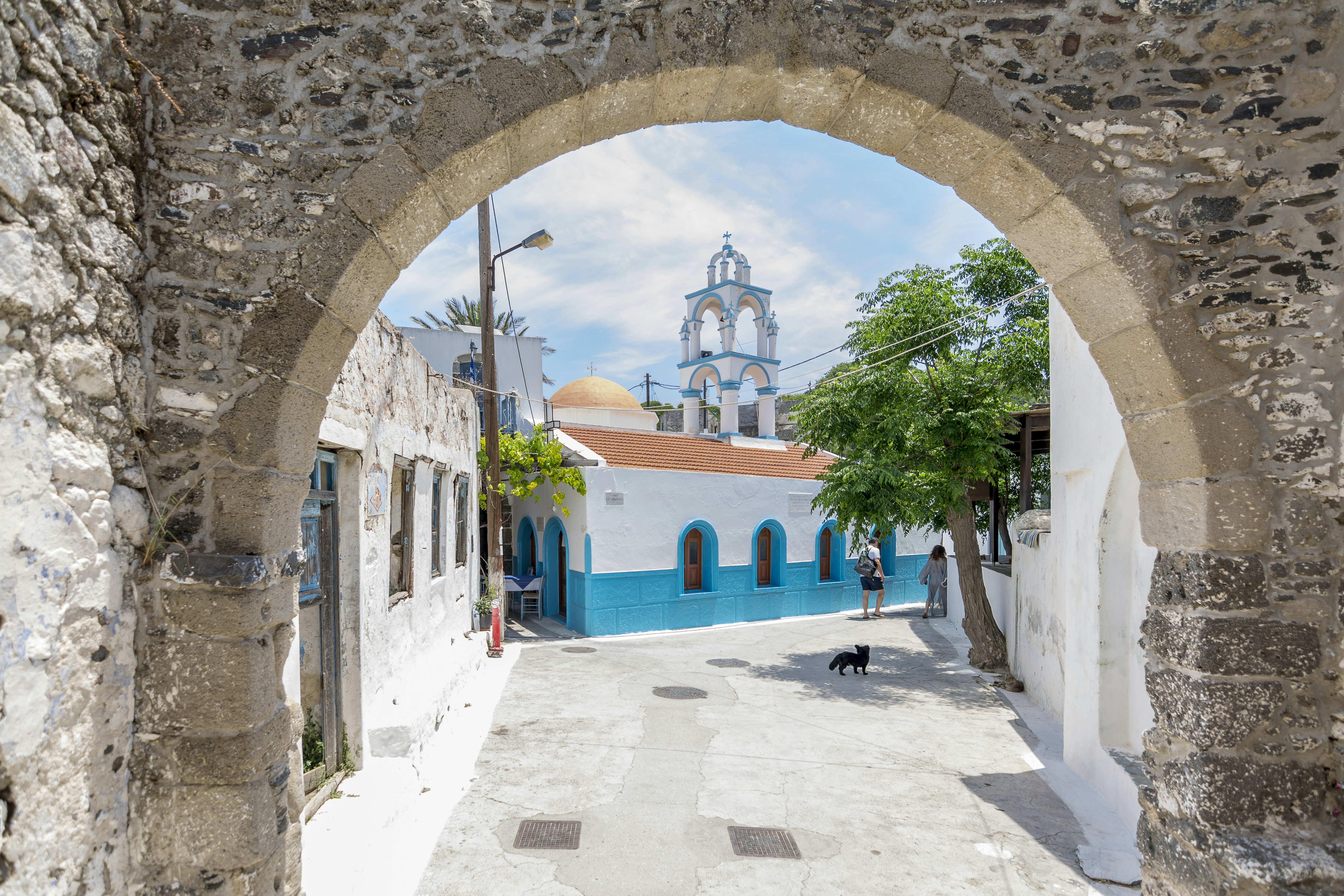
4. Nisyros
Best for crowd-free caldera climbs
Santorini gets all the fuss, but Nisyros is an island of equally smouldering beauty minus the crowds. With an active volcano and lunar landscapes at its heart, this dinky island in the Dodecanese bubbled up from the Aegean Sea 150,000 years ago. Legend has it that the hissing fumaroles at its caldera are created by a grumbling giant.
Half-asleep giants aside, the island gets our vote for its marvelously laid-back feel that’s a taste of Greece before tourism got a grip. Days here play out slowly in cliff-top, chalk-white villages crowned by blue-domed churches. Among olive groves and vines, enjoy secluded coves washed by the bright-blue sea, before retreating to a taverna for a lazy lunch or kafeneio (coffee house) for drinks and a game of backgammon. You might never want to leave.
Planning tip: Nisyros is just a 50-minute ferry ride from Kos in the Dodecanese Islands. Base yourself in the tiny capital, Mandraki.

5. Mykonos
Best for starry nights and party vibes
It was Mykonos that broadcast the beauty of the Cyclades to the world in a big way in the 1989 romcom Shirley Valentine, which had everyone dreaming about ditching the day job and drizzle and heading to a sunny beach for good. Since then, Mykonos has carved out a reputation as the party-mad glamour-puss of the Greek islands, attracting everyone from bikini-posing influencers and Instagrammers to gay revelers at legendary beach clubs like Paradise and Super Paradise by day, and pumping megaclubs like clifftop Cavo Paradiso by night.
Between cocktails and DJ sets, squeeze in time to roam the whitewashed lanes of medieval capital, Hora, rest up on the powder-soft sands of beaches like Agios Sostis, and bike along narrow backcountry lanes to tiny villages and 16th-century Tourliani Monastery.
Planning tip: Need a break from all the partying? Come in the shoulder seasons for a quieter feel (and cheaper accommodations), or swing over to more tranquil neighboring islands like Paros, Naxos and Delos.

6. Rhodes
Best for historic escapades
The biggest island in the Dodecanese, Rhodes has cast a spell on visitors to its shores for millennia, and it still hasn’t lost its touch. The island is a mega shot of everything that makes Greece great: high-punching history, gold-sand beaches, forested valleys, cypress-brushed hills and crystal-clear seas for watersports.
When it comes to history, however, Rhodes really turns up the drama. For a cultural deep dive, top billing goes to Rhodes Town, which wings you back through epoch-spanning layers of history from the Byzantine to Classical, Ottoman and Italian eras. A Unesco World Heritage site, the double ring-walled medieval city presents a fascinating romp back in time, with mazy cobbled streets and the Knights’ Quarter, where the Knights of St John built fortress-like mansions and the magnificent Palace of the Grand Master in the 14th and 15th centuries. In a former Knights' Hospital, the Archaeological Museum enthrals with its stash of ancient mosaics and marble statues.
Skipping south, Lindos is a lovely-as-can-be vision of whitewashed houses and tangled lanes, tumbling down to a turquoise bay. Standing sentinel on a rocky headland, its showstopper Acropolis, with battlements built by the Knights of St John, has mood-lifting views out to sea.
Planning tip: Give the crowds and cruise ships the slip by visiting outside of the peak summer months of July and August. The heat and visitor numbers are far less intense during the shoulder months (April to early June and September to October).

7. Samothraki
Best for conversing with the Gods
As if cupped in celestial hands among high, rugged mountains, thick forests of oak, cedar and pine, roaring mountain streams and fern-filled, waterfall-splashed gorges, Samothraki in the Northern Aegean is remote, wild and wondrous. Capping things off is 1611m (5285ft) Mt Fengari, the perch from which Poseidon watched the fall of Troy. This is an island for slowing the pace and embracing the outdoors, whether cooling off in emerald vathres (natural plunge pools), hiking into the goat-grazed heights or reclining on the creamy sands of a gorgeous bay like Pachia Ammos.
On this under-the-radar island, you can tune into Homeric myth and untap the mysteries of the past. The enigmatic Sanctuary of the Great Gods, a temple built by the Thracians to worship their fertility deities around 1000 BCE, is unmissable. The secret rites and rituals practised by the cult later attracted the likes of Egyptian queen Arsinou. A path leads up to the Nike monument (nike means "victory" in Greek), where the Winged Victory of Samothrace sculpture once stood looking out to sea (it’s now in the Louvre in Paris).
Planning tip: Zante Ferries runs daily ferries from mainland Alexandroupoli during summer. The journey takes around 2 hours.

8. Kefallonia
Best for rugged romance
Neighboring Corfu is popular, but there’s magic in the air on Kefallonia, the largest – and arguably loveliest – of the Ionian Islands. An island of cinematic beauty, it seduces with blond-sand beaches easing into startlingly turquoise seas, remote high mountains and a hinterland entangled with cypresses and oaks, vines and olive groves. These poetic landscapes stole hearts and shouted “Visit Greece!” when they appeared as the seductive backdrop in the 2001 wartime romance movie, Captain Corelli's Mandolin.
You could spend weeks hiking and cycling on Kefallonia and barely touch the surface, but high on any wish list is a visit to Myrtos beach, where a road helter-skelters down to a cliff-wrapped bay and near-luminous blue sea so lovely you’ll pinch yourself. For a history fix, swing by the pretty Venetian harbor of Fiskardo and Agios Georgios Kastro, a romantically ruined 16th-century fortress with mood-lifting views over the island to Corfu.
Planning tip: The neighboring isle of Ithaki, a 25-minute ferry ride away, swirls in Homeric legend as the mythical home of Odysseus. This rugged island is brilliant for exploring on foot, with old mule trails crisscrossing hills to harbour villages, evocative ruins and the occasional beautiful beach.

9. Kythira
Best for relaxed breaks
Where the vibrant blue Ionian and Aegean seas meet, Kythira is just a pebble-skim south of the Peloponnese and light years away from the rush of modern life. Things move refreshingly slowly on this time-capsule of an island, a remote outlier of the Ionian Islands. And what a beauty it is, with its cliff-clasped bays, waterfall-splashed gorges and Cycladic sugar-cube architecture. In the hinterland, traffic-free roads unravel through orchards, vineyards and olive groves. Love at first sight? Well, what do you expect on the island that, according to legend, gave birth to the beautiful goddess Aphrodite? The Cypriots, who also claim to have the birthplace of Aphrodite, are mistaken, according to locals.
Linger for more than a few days to really touch the soul of the island, factoring in visits to the likes of the strikingly photogenic village of Hora, topped off by a once-mighty Venetian fortress, and the medieval Paleochora, once the island’s Byzantine capital.
Planning tip: Triton Ferries operate twice daily sailings between Neapolis in the Peloponnese and Kythira in the high season. The crossing takes 1¼ hours.

10. Santorini
Best for volcanic drama
Arriving by sea and sailing into the enormous crater of its drowned volcano, the romance of Santorini is very real. The sea and sky are searing blue, cliffs rise sheer and rugged above black-sand bays, guiding the eye to white cubist houses and cobalt blue-domed churches – this is the Greece of a million postcards. But, let’s face it, you’re not the only one who thinks so. With a year-round population of 15,500 and visitor numbers peaking at 3.4 million in 2024, this dinky island in the Cyclades has become a poster-child for overtourism. If you do come, be sure to avoid the peak summer months when the island groans under the weight of Instagrammers and cruise-ship daytrippers.
But come you should. Built on the steep slopes of a caldera, towns like Oia and Fira give a luxe edge to the volcanic backdrop, with glam cave houses, boutique hotels with infinity pools and cliffside tavernas where you can dig into boat-fresh fish and watch sunsets that pop. For more depth, hook onto a guided hike up the island’s still-active volcano for stirring views across the ashen landscape, or discover a real-life Atlantis among the Bronze Age ruins of the Minoan Ancient Akrotiri.
Planning tip: Like the look and feel of Santorini but not its crowds? Take a 50-minute SeaJets ferry ride over to the far quieter island of Folegandros.

11. Samos
Best for sweet wines and lush valleys
Sliding into the cerulean waters of the eastern Aegean and just a wave away from Turkey, Samos is an instant-heart-stealer, with a necklace of blond-sand beaches backdropped by a wild, mountainous interior. Vineyards stagger down dry-stone terraces called pezoules and river-woven, densely forested valleys rise up to the highest peak, 1434m-Kerkis (4705ft). Grapes have been cultivated here since 1200 BCE and today the island’s muscat – as golden as the sun and as sweet as honey – sends wine lovers in raptures.
Legendary birthplace of goddess Hera and home to the World Heritage ruins of her ancient sanctuary, Heraion, this island packs a massive historic punch. Other ancient wonders worth seeking out include the Evpalinos Tunnel, a 6th-century BCE aqueduct burrowing deep into a mountainside, and the Archaeological Museum of Pythagorio.
Planning tip: The island is magical in spring, when you can forage for wild herbs, hear the high-pitched call of nightingales and walk trails threading through wildflower meadows to the whitewashed villages of the hinterland.
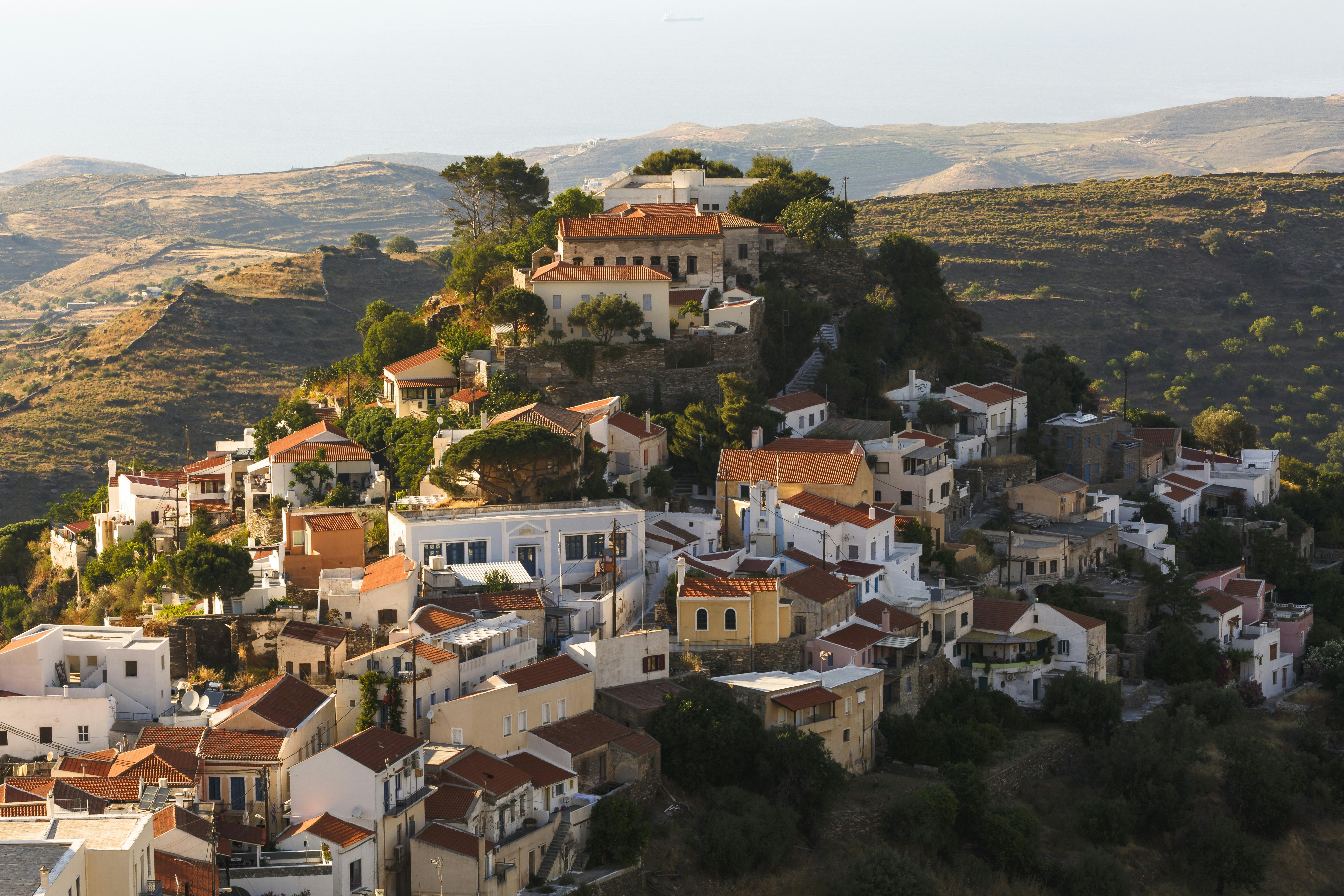
12. Kéa
Best for an island escape near Athens
Arrive on wild, serene, heart-racingly lovely Kéa and it seems crazy that Athens is just an hour’s ferry hop away. While the island is no secret to Athenians eager to escape the boiling heat of the capital in summer, everyone else is only just cottoning on to its beauty. On the coast, pine-cloaked cliffs plunge to gold-sand bays and glassy waters where you can dive deep to shipwrecks. Inland, time-lost, hill-hugging villages serve up an authentic slice of Greek life, and cobbled paths twist into vineyards, olive groves and ancient oak forests. Idyllic? You bet.
If history piques your interest, squeeze in a visit to the Archaeological Museum in Ioulis, rammed with intriguing artefacts. Only accessible by boat or on foot, the ancient city of Karthaia and its acropolis temples enthralls too, as does the 8m-long (26ft) Lion of Kéa, carved out schist between the 9th and 6th century BCE. Further north, the coastal road snakes dramatically up to clifftop, 18th-century Kastrianis Monastery, where miracles have been attributed to the Virgin Mary. The views out across the Aegean to the neighboring isle of Andros are special.
Planning tip: Triton Ferries operate multiple daily crossings between Athens and Kéa. Sidestep the summer holidays for a calmer atmosphere and far fewer crowds.



